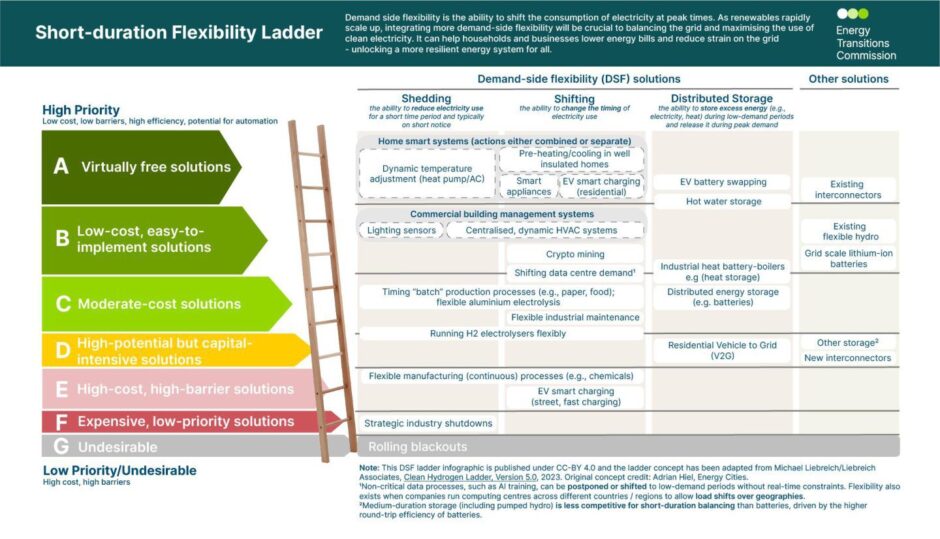Demand-side flexibility, which is the ability to shift or shed electricity consumption during peak times, is an underestimated but critical part of expanding clean power systems.
As future power systems will largely rely on variable generation from wind and solar, demand flexibility across growing electricity users can reduce strain on the grid by smoothing peaks, offsetting more expensive and often higher-emitting generation, and therefore reduce costs and speed up decarbonisation.
Demand flexibility is already here today, as consumers can dynamically adjust some consumption and save money in response to price signals; however, the opportunity is even greater as the scale of automated responses grows.
For example in 2023, Octopus energy customers on an “Agile” tariff saved hundreds of pounds (versus being on a standard tariff), through shifting energy use.
Examples of demand flexibility include: charging electric vehicles (EVs) during off-peak hours, heating or cooling rooms a few hours ahead of need in insulated buildings (“pre-heating” or “pre-cooling”), and thermal energy solutions that store and discharge heat for industrial processes (“industrial heat batteries”), lessening peak loads and reducing electricity bills.
Data centres also have some potential to perform non-critical data processes at low electricity demand periods – and companies with international operations could choose to shift loads across geographies, taking advantage of regional fluctuations in supply and demand.
Demand flexibility offers an affordable, secure route to planning future energy systems, helping to lower upfront investment needs, system running costs and consumer bills. While the expansion of grid capacity and energy storage remain critical for future systems, thanks to the growth of electrification and automated flexibility solutions, demand is now poised to play a larger role in helping to actively balance power systems.
Demand flexibility could also help to offset immediate needs for grid upgrades, reducing uptake barriers as electrification expands.
Recent analysis from the Energy Transitions Commission estimates that a third of global electricity demand in 2050 could be flexible, around the equivalent to today’s global electricity consumption.
Global electricity demand is expected to increase from around 29,000 TWh today to around 80,000 TWh or more by 2050 in an electrified, decarbonised energy system. We estimate around 20% of electricity demand from buildings, 45% of industry, and 50% of passenger EV electricity demand could be flexible by 2050.
Across the demand flexibility landscape, low-cost, highly automatable solutions should be prioritised. For example, home heating or cooling and running appliances at optimal times could be achieved at no additional expense as modern smart appliances are installed with built-in shifting capabilities.
Also, smart charging EVs during off-peak times can be automated and requires no additional investment for EV owners – unlike vehicle-to-grid (V2G) technology, which enables EVs to discharge power back to the grid, but can require additional capital investment in bidirectional chargers and vehicle adaptations.
Industrial heat batteries, which convert variable renewable electricity as heat and enable continuous, high-temperature heat supply, are effective flexibility and decarbonisation technologies, but roll-out so far has been limited due to higher upfront costs and grid access constraints.
Addressing regulatory barriers is critical to scale demand flexibility. Significant cost savings can incentivise flexibility, but large-scale adoption will require a united approach across technologies and stakeholders within the energy landscape.
Firstly, regulators and operators must set attractive pricing mechanisms such as time-of-use tariffs and lower electricity prices at off-peak times.
Secondly, market reforms will be necessary to expand flexible electricity procurement capabilities for Distribution System Operators (DSOs) and Transmission System Operators (TSOs), and software must be deployed to enable end-to-end automated integration and optimisation.
Thirdly, some financial support (e.g., through government-backed grants) via Energy Service Companies (ESCOs) could help to support flexibility solutions and services that help remove the burden on consumers. It will also be critical to ensure smart meter rollout, transparent billing, and education around the benefits of flexibility to promote change.
As countries commit to national decarbonisation plans known as Nationally Determined Contributions by September this year, ahead of COP30, this represents a critical opportunity for demand flexibility to be elevated within plans to deliver clean, cost-effective and resilient power systems globally – a critical enabler to the global vision of tripling renewables by 2030.
The UK’s Clean Power 2030 Action Plan sets an example, with a target to increase demand flexibility by four to five times from today’s levels, reaching 10-12 GW of consumer-led flexibility capacity by 2030. National action plans should urgently prioritise low-cost demand flexibility, alongside clean electricity generation, energy storage and grid infrastructure.



 © Supplied by Energy Transitions C
© Supplied by Energy Transitions C






